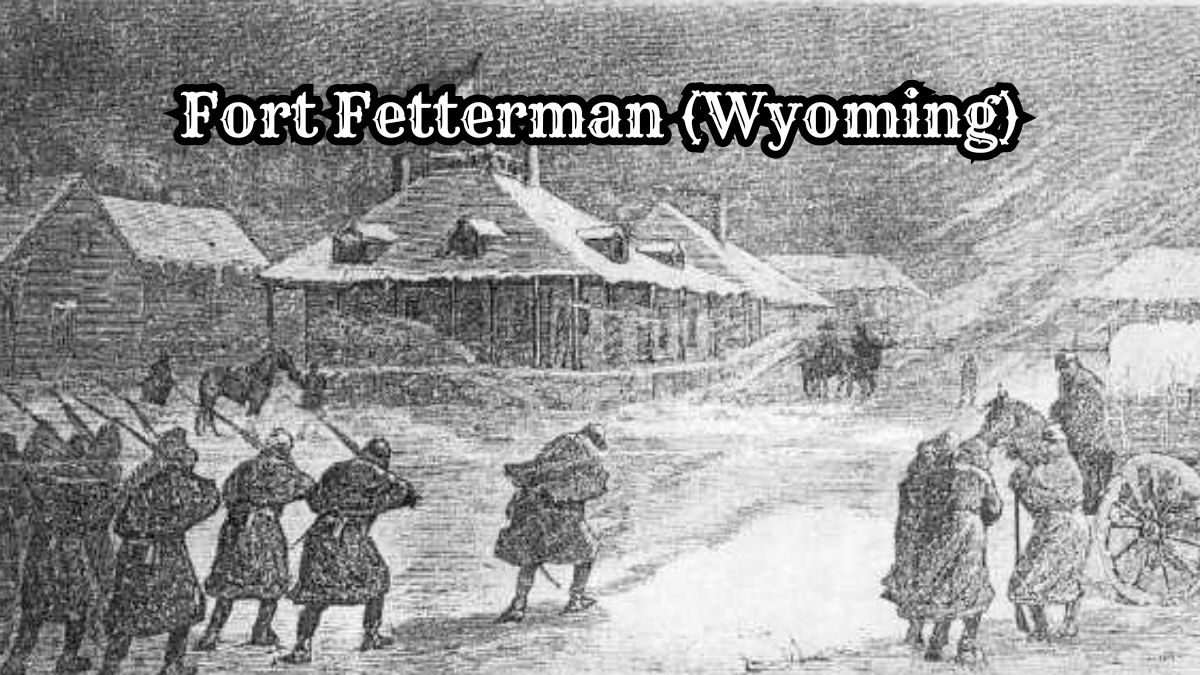Fort Fetterman, located near the North Platte River in Wyoming, is rich in American history.
Established in 1867, this military post played a critical role during the era of Westward Expansion, serving as a crucial point for military expeditions and a protector of emigrants.
Named after Captain William J. Fetterman, the fort witnessed significant interactions and conflicts with Native American tribes.
Though abandoned in 1882, Fort Fetterman remains a symbol of the complex and often turbulent history of the American frontier, now preserved as a state historic site for public education and reflection.
History of Fort Fetterman (Wyoming)
Fort Fetterman was pivotal at the intersection of Native American history and Westward Expansion.
Its establishment, conflicts, and eventual decline encapsulate a significant period in the American frontier narrative.
Establishment and Military Role

Fort Fetterman was established on July 19, 1867, near the North Platte River on land that became part of the Wyoming Territory.
Named in honor of Captain William J. Fetterman, it served as a military post when the region was known as Indian Country.
The fort’s primary purpose was to protect emigrants and maintain peace, acting as the northernmost anchor point for military expeditions.
Major William McEnery Dye was critical in its founding and subsequent operations.
The strategic location of Fort Fetterman allowed for control over routes leading to the Montana gold fields.
It was essential for its military role but also as a launching point for campaigns against Plains Indian tribes, which conflicted with the U.S. military expansion.
Native American Relations
Relations with Native American tribes such as the Arapaho were marked by tension and conflict, primarily due to the expanding frontier encroaching on tribal lands.
Notably, the Treaty of Fort Laramie, signed in 1868, aimed to bring peace between the U.S. and various tribes by defining territories.
However, violations of the treaty by settlers and prospectors led to hostilities.
Although the infamous Fetterman Fight in 1866 occurred before the fort’s establishment, it is often associated with the Fort’s history.
The engagement exemplifies the lethal conflicts between the U.S. military and Plains Indians, and its outcome influenced military strategy and fortifications like Fort Fetterman.
Decline and Abandonment
By the late 1870s, the relevance of forts like Fetterman diminished as the threat of Indian wars receded with the decline in Native American resistance.
Subsequent policy, as enacted by the U.S. government, led to abandoning all forts designed to control the Indian Country.
Fort Fetterman was officially abandoned in 1882.
The soldiers left behind buildings and military records, which today, under the oversight of the Wyoming Historical Commission, are part of the Fort Fetterman State Historic Site.
The site now stands as a reminder of that colorful era, marking the end of the Indian Wars and offering a glimpse into the experiences shared by soldiers, settlers, and Native American tribes in the Wyoming Territory.
Cultural Impact and Preservation

This section examines how Fort Fetterman has been preserved for historical relevance and public education, providing insight into the site’s cultural significance.
Historical Reconstruction
The Fort Fetterman Historic Site has been carefully preserved to maintain the authenticity of the Old Fort.
Interpretive signs guide visitors through the area, offering historical context and highlighting the visible foundations of buildings that once stood on the site.
Efforts to reconstruct parts of the fort, including the Restored Officer’s Quarters and the Ordnance Warehouse, provide a tangible connection to the past.
Public Engagement and Education
Wyoming State Parks manages the Fort Fetterman State Historic Site and provides numerous educational opportunities for the public.
An interpretive trail winds through the fort, featuring various exhibits that educate visitors about the fort’s inhabitants’ daily lives and their roles in regional history.
Artifacts of the Fort are displayed in the Park Headquarters to engage visitors further.
For those seeking further information, an email address is available for inquiries about the site’s history and preservation efforts.
Explore More: 15 Historic Forts in Wyoming
Geography and Logistics
Fort Fetterman, established in Wyoming, played a strategic military and logistical role during its operational period. It was an essential supply point and a gateway to the West for military and civilian ventures.
Strategic Location
Fort Fetterman was positioned on the North Platte River, near the valleys of LaPrele Creek.
This placement made it a critical juncture along the Bozeman Trail, a vital overland route connecting the gold rush territory of Montana to the rest of the United States.
Its proximity to the town of Douglas, later known as present-day Douglas, underscored its importance as a frontier military outpost.
The fort’s strategic location allowed it to function as a staging area for several military campaigns, including the Big Horn Expedition.
- Bozeman Trail: Served as a primary route for northwest migration.
- North Platte River: Provided a water source and formed part of the regional transport network.
- Valleys of LaPrele Creek: Offered a strategically advantageous location near key topographical features.
Development and Infrastructure
The establishment of Fort Fetterman was a significant undertaking involving considerable construction to support its role as a strategic supply base.
As a significant supply point, it facilitated the distribution of goods and resources to the surrounding areas and to further military expeditions.
Major Supply Point:
- Serviced the needs of soldiers and civilians of Fort Fetterman.
- Acted as a logistical hub for supplying supplies to various military expeditions.
Line of the Union Pacific Railroad & Remote Location:
- The fort was a short distance from the line of the Union Pacific Railroad, enhancing its access to supplies.
- Despite its remote location, Fort Fetterman maintained logistical efficacy and served as the military’s critical operational base.
Infrastructure:
- Military Structures: Built to house troops and store supplies.
- Civilian Businesses: Supported the needs of the military as well as civilians.
Today, the site is managed by the Wyoming Division of State Parks and Historic Sites, which preserves Fort Fetterman’s history and legacy as a testament to its once pivotal role in the American West.

Cory is a website owner and content creator who enjoys fishing, history, coin collecting, and sports, among other hobbies. He is a husband and father of four.
Romans 15:4 For whatever was written in former days was written for our instruction, that through endurance and through the encouragement of the Scriptures we might have hope.

